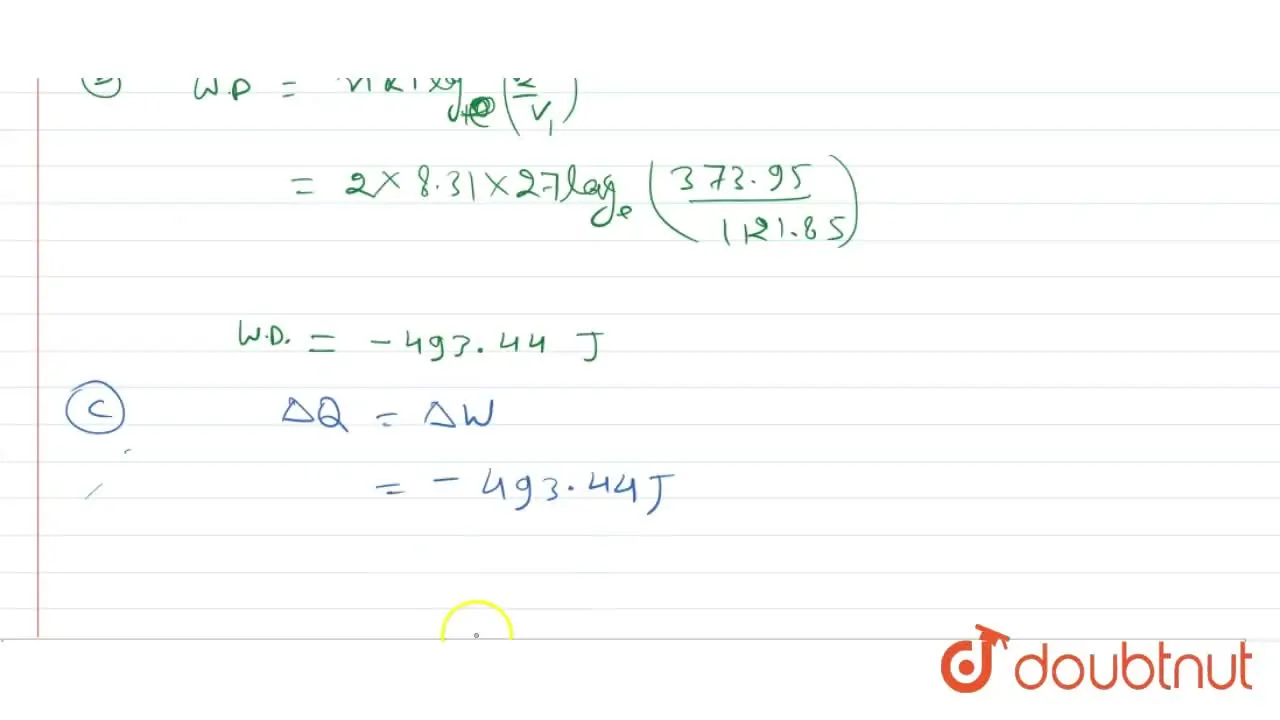A 2.00 mol sample of helium gas initially at 300 K and 0.400 atm is compressed isothermally to 1.20 atm. Noting that the helium behaves as an ideal gas, find (a) the final volume of the gas, (b) the work done on the gas and (c ) the energy transferred by heat.
The final volume will be one-third of the original, for the temperature to be constant, the sample must liberate as many joules by heat as it takes in by work.
The ideal gas law can tell us the original and final volumes. The negative integal of PdV will tell us the work input, and the first law of thermodynamics will tell us the energy output by heat.
a. Rearranging PV=nRT, we get Vi=nRTPi
The initial volume is
Vi=(2.00mol)(8.314JmolK)(300K)(0.400atm)(1.013×105Pa/atm)1PaN/m2
For isothermal compression, PV is constant, so PiVi=PfVf
Vf−Vi(PiPf)=(0.123m3)(0.400atm1.20atm)=0.0410m3
b. W=−∫PdV=−∫nRTVdV=−nRT1n(VfVi)
=−(4988J)1n(13)=+5.48kJ
c. The ideal gas keeps constant temperature so ΔEint=0
=Q+W and the heat is Q=−5.48kJ
Related Playlists
- BOOK - CENGAGE PHYSICS ENGLISHCHAPTER - KINETIC THEORY OF GASES AND FIRST LAW OF THERMODYNAMICSEXERCISE - Solved Examples14videos
KINETIC THEORY OF GASES AND FIRST LAW OF THERMODYNAMICS
- BOOK - CENGAGE PHYSICS ENGLISHCHAPTER - KINETIC THEORY OF GASES AND FIRST LAW OF THERMODYNAMICSEXERCISE - Exercise 2.120videos
KINETIC THEORY OF GASES AND FIRST LAW OF THERMODYNAMICS
- BOOK - CENGAGE PHYSICS ENGLISHCHAPTER - KINETIC THEORY OF GASESEXERCISE - Compression2videos
KINETIC THEORY OF GASES
- BOOK - CENGAGE PHYSICS ENGLISHCHAPTER - LINEAR AND ANGULAR SIMPLE HARMONIC MOTIONEXERCISE - Single correct anwer type14videos
LINEAR AND ANGULAR SIMPLE HARMONIC MOTION
Similar Questions
An ideal gas is compressed at constant pressure of 105Pa until its volume is halved. If the initial volume of the gas as 3.0×10−2m3, find the work done on the gas?
View SolutionA sample of helium gas is at a temperature of 300K and a pressure of 0.5atm. What is the average kinetic energy of a molecule of a gas ?
View SolutionHow many moles of Helium gas occupy 22.4L at 0C and 1atm pressure
View SolutionHow many moles of helium at temperature 300K and 1.00 atm pressure are needed to make the internal energy of the gas 100J?
View SolutionHow many moles of helium at temperature 300K and 1.00 atm pressure are needed to make the internal energy of the gas 100J?
View Solution(a) A certain mass of gas initially at (1L,5atm,300K) is expanded reversible and isothermally to final volume of 5L, calculate the work done by the gas and heat supplied in this process to the gas.
(b) Now, if the gas is released to initial position by compressing it using an external constant pressure of 5 atm. Find work done on the gas in this process and heat rejected by gas
(c ) In the above two processes, what is the net gained by surroundings ?
[Note: From above question see that surrounding has done extra work on the system but system has returned that work in the form of heat to surrounding and work is considered on organized form of energy while heat as an unorganised form hence in the above process, there must be net increment in randomness of universe which be called Entropy, soon]View SolutionA gas at a pressure of 1 atm is compressed at a constant pressure from 10.0 litres to 2.0 litres. If 500 J of heat energy leaves the gas calculate (i) the work done by the gas and (ii) the change in its internal energy.
View SolutionTwo sample A and B of a gas initially at the same pressure and temperature are compressed from volume V to V/2 (A isothermally and B adiabatically). The final pressure of A is
View Solution8.2 L of an ideal gas weights 9.0 g at 300 K and 1 atm pressure. The molecular mass of the gas is
View SolutionA tank used for filling helium balloons has a volume of 0.3m3 and contains (2.0) mol of helium gas at 20.0∘C. Assuming that the helium behaves like an ideal gas.
(a) What is the total translational kinetic energy of the molecules of the gas ?
(b) What is the average kinetic energy per molecule ?View Solution


